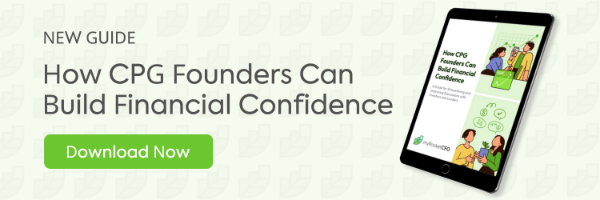Clayton Christensen is a Harvard Business School Professor who coined the term "disruptive innovation." His research shows that 30,000 new consumer products are introduced each year in the U.S., with a failure rate of up to 95%. And unfortunately, more than 80% of new CPG companies never reach the $1 million mark in revenue.
If you run a CPG business, you know the odds are tough. However, the potential payoff can be huge—economically and personally. Rarely do CPG founders go it alone. Partners and investors are often crucial to your success, and the best of them will ask tough questions to ensure you stay on track. Sometimes, these conversations can get intense — especially if you don’t know your numbers.
Improving Financial Discussions With Partners and Investors
There are four key areas that should guide your interactions when discussing financial metrics:
- Preparation: Produce accurate and comprehensive financial reports with the appropriate level of detail.
- Financial Stability: Demonstrate a pathway to profitability and sustainable growth.
- Leveraging Accountability: Utilize the expertise of your financial advisor and CFO tools.
- Confidence: Present financial data confidently, showing you truly understand what’s behind the numbers.
Key Financial Metrics for CPG Founders and Startups
Investors and partners are deeply invested in your business's financial success. Demonstrating your financial acumen is crucial for guiding your company effectively. Here are key financial metrics and terms you should be comfortable discussing:
Accounting and Bookkeeping Terms
- Accrual-Based Accounting: An accounting method where revenues and expenses are recorded when they are earned or incurred, regardless of when cash is actually received or paid.
- Accounts Payable (AP): The amounts you owe to suppliers.
- Accounts Receivable (AR): The amounts customers owe you.
- COGS (Cost of Goods Sold): The direct costs of producing the goods you sell, including materials and labor.
- Gross Profit Margin: The difference between revenue and the cost of goods sold, expressed as a percentage of revenue.
- Gross sales vs. net sales: Gross sales is your total sales amount, while net sales subtracts returns, allowances, and discounts.
- Operating Cash Flow (OCF): The cash generated from the normal operations of a business.
- P&L Statements (Profit and Loss Statements): A financial report summarizing your revenues, costs, and expenses over a specific period, showing whether your company made a profit or loss.
- Reconciliation: The process of comparing financial records to ensure they match.
- Working Capital: The difference between your current assets and liabilities, indicates short-term financial health.
Investment and Financing Terms
- Angel Investor: An individual who provides capital for a startup, often in exchange for convertible debt or ownership equity.
- CapEx (Capital Expenditures): Money spent to buy or upgrade physical assets.
- Cap Table (Capitalization Table): A table that shows the ownership stakes in your company, including equity shares, convertible equity, and options.
- Convertible Note: A type of short-term debt that converts into equity, typically in conjunction with a future financing round.
- Debt Financing: Raising capital by borrowing money that must be repaid over time, usually with interest.
- Debt-to-equity ratio: A measure of how much of your financing comes from debt versus equity.
- Dilution: The reduction in ownership percentage of existing shareholders due to the issuance of new equity shares.
- Due Diligence: The process of investigating a business or individual before signing a contract or making an investment.
- Equity Financing: Raising capital through the sale of shares in your company.
- Exit Strategy: A plan for how an investor will leave their investment in your company and realize their profit.
- Internal rate of return (IRR): The annual growth rate expected from a project or investment.
- Lifestyle Business: A business focused on generating income to support the owner's lifestyle, with no plans for rapid growth or selling.
- Market Capitalization (Market Cap): The total value of your company's outstanding shares of stock.
- Pre-Money Valuation: The valuation of your company before it receives external funding or investment.
- Post-Money Valuation: The valuation of your company immediately after it has received external funding or investment.
- ROI (Return on Investment): A measure used to evaluate the efficiency or profitability of an investment.
- Run Rate: A projection of a company’s annual revenue based on current performance, typically calculated by multiplying one month’s revenue by 12.
- Search Fund Accelerator: A program that equips entrepreneurs with funding, mentorship, and resources to help them acquire and manage SMBs successfully.
- Term Sheet: A non-binding agreement outlining the basic terms and conditions under which an investment will be made.
- Tranche Funding: This is a method of releasing investment capital in stages or "tranches" based on the achievement of specific milestones.
- Venture Capitalist: An investor who funds high-growth startups in exchange for equity, aiming for significant returns.
- Vesting: The process by which an employee earns the right to receive stock options or equity over time.
Business Operations and Performance Metrics
- Break-Even Point: The revenue you need to pay your expenses. You’ve got to hit break-even before you start turning a profit.
- Burn Rate: How quickly your company is spending its cash reserves.
- Contribution Margin: The portion of sales revenue that isn't consumed by variable costs and contributes to covering fixed costs — crucial for pricing strategies.
- Customer Acquisition Cost (CAC): The cost of gaining a new customer — critical to maintaining margins.
- Customer Lifetime Value (CLV): How much revenue you can expect from each customer over your entire relationship with them.
- DSO (Days Sales Outstanding): A measure of the average number of days it takes a company to collect payment after a sale.
- EBIT (Earnings Before Interest and Taxes): A measure of your company's profitability that excludes interest and income tax expenses.
- EBITDA (Earnings Before Interest, Taxes, Depreciation, and Amortization): A measure of your company's overall financial performance, excluding some non-operating expenses.
- Inventory Turnover: How many times you sell and replace your inventory over a period.
- M&A Accounting (Mergers and Acquisitions Accounting): The specialized accounting practices involved in consolidating companies' financial statements that merge or are acquired, ensuring proper valuation and reporting.
- Net Operating Profit After Tax: Your company's after-tax operating profit, assuming no debt.
- Net present value (NPV): The current value of future payment streams.
- Net profit: What's left of your revenue after all expenses, taxes, and costs are paid (i.e., the bottom line).
- Operating Expenses (OpEx): The costs associated with running your business day-to-day.
- Profitability Analysis: An evaluation of your company's ability to generate profit relative to its expenses, often involving metrics like profit margins and return on investment.
- Runway: The amount of time your business can operate before running out of cash, based on the current burn rate.
Funding Stages
- Pre-Seed Funding: This is the earliest stage of funding, often from the founders themselves or close supporters, used to develop a business idea and initial operations.
- Seed Funding/Seed Money: The initial capital raised to start a business, typically from founders, friends, family, and angel investors, used to fund early development and operations.
- Series A Funding: The first significant round of venture capital financing, typically used to scale the business after proving the concept.
- Series B Funding: A second round of venture capital financing that helps a company expand further, often involving scaling up production, sales, and marketing.
- Series C Funding: A third round of venture capital financing focused on scaling the company quickly, possibly to prepare for an acquisition, merger, or IPO.
Enhance Your Financial Storytelling: A Guide for CPG Founders
Understanding these financial terms is crucial for meaningful conversations with investors and partners, but the real value comes from being able to weave them into a compelling narrative about your business’s growth and potential. To help you master this skill and gain deeper insights into effectively managing your financials, download our ebook, How CPG Founders Can Build Financial Confidence. In this resource, you’ll learn:
- How to access your real-time financial data to resonate better with investors.
- Techniques for demonstrating financial stability and growth potential.
- Strategies for confidently presenting your company's financial standing to inspire trust and secure partnerships.
Download the guide and take the next step in solidifying your financial foundation.






